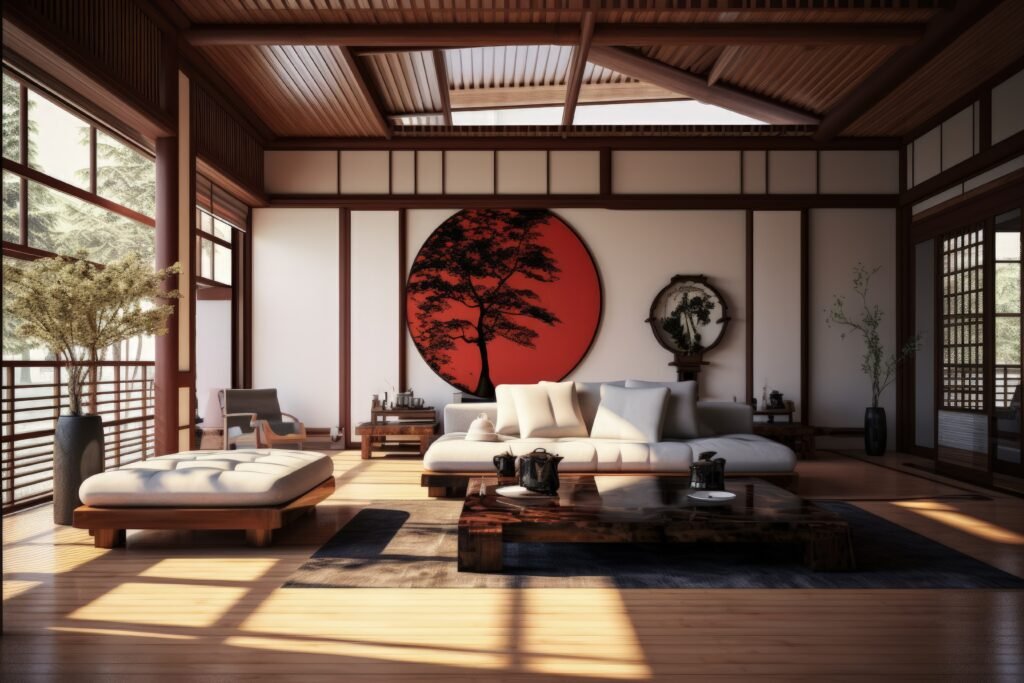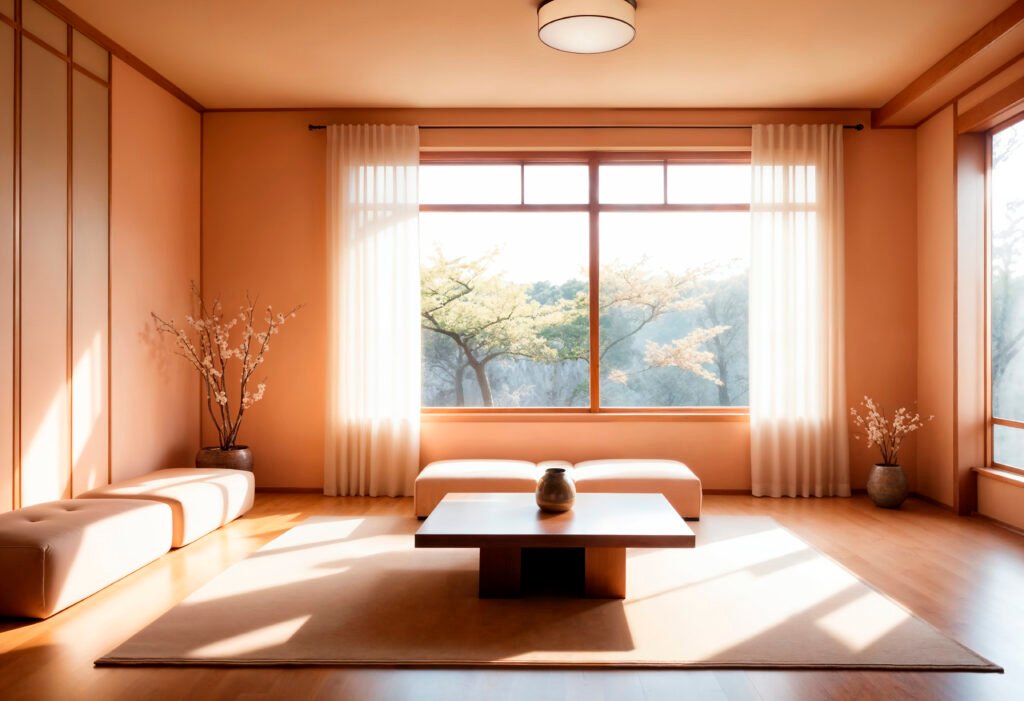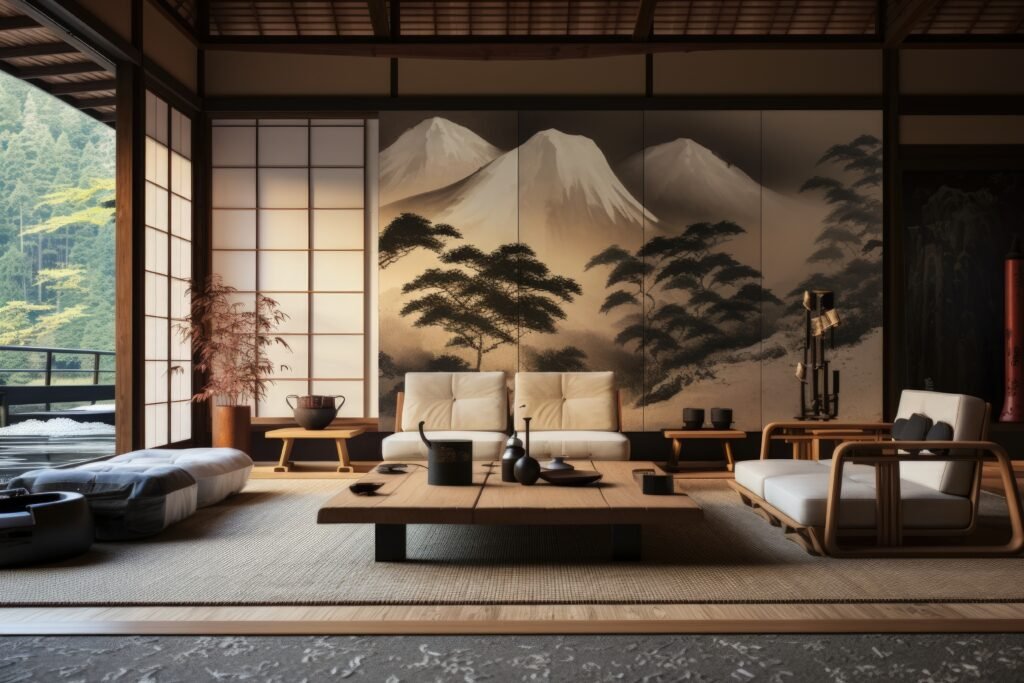“Japanese style living room I love designing rooms, “As a room design expert, I love creating serene spaces. My Japanese living room design expertise will help you get 15 essential elements to transform your home.” .” Let us see”.
Picture entering a living room that soothes every one of your senses, a space that blends beauty with comfort. It is a Japanese Living Room design philosophy. Japanese decoration is deeply rooted in minimalism, natural materials, and a love for simplicity, giving rise to a serene yet sophisticated environment. This article will examine 15 elegant Japanese living room ideas that will turn your house into a peaceful getaway.
Embrace Minimalism
In my point of view, Minimalism is at the heart of Japanese decor. It requires removing all the unnecessary clutter from your living space and concentrating only on selected items. Reducing what is around you while focusing on the critical aspects creates an open and relaxed atmosphere. Look at your current ornaments, and start by discarding things that serve no functions or make you happy. It is crucial to have a streamlined, uncluttered living environment. Cutting down on excessive items makes the few that remain more pronounced and creates a calm, harmonious setting. Apart from the clear appeal, this thinking greatly improves mental well-being. Use natural materials, neutral colors, and functional shapes to achieve Japanese minimalism. These work together and result in calming ornaments.
Use Natural Materials
Materials like wood, bamboo blinds, and stone give Japanese designs a sense of nostalgia. Such creations give a touch of nature inside the home, making the people grounded and calm. Try wooden furniture, stone accessories, and bamboo blinds to help bring the indoors together with nature. Wooden furniture adds warmth, bamboo blinds give soft light, and stone accessories add rugged beauty. Together, these materials create a holistic balance for a peaceful haven. Using these materials in your decor not only elevates the appeal of your space but also brings in elements of nature that are calming to the mind and body.
Incorporate Sliding Doors (Shoji)
Shoji screens are a form of traditional Japanese sliding doors with wooden frames intertwined with translucent paper, allowing light to sleep in while providing a sense of privacy. These can also serve as room dividers or curtains, which gives your living room an authentic appeal. Their design improves natural light, bringing calmness and openness to a room. Moreover, shoji screens allow minimalism by suggesting division without the bulkiness of real walls. When used as decorations, shoji screens provide beauty and practicality simultaneously. Their combination of functional and aesthetic appeal is a testament to the boundless ingenuity of Japanese designers. Their timeless design and beauty make shoji screens ideal for a tranquil and peaceful living space, perfectly serving their purpose.
Introduce Tatami Mats
I prefer Tatami mats, made from rush grass and rice straw, which are essential in Japanese interiors. They provide your space’s comfort and elegance while maintaining its natural beauty. The whole floor can be covered with tatami mats or a separate sitting arrangement can be made in the living room, making them more functional. They also promote comfort by soothing relaxation, as their soft texture makes them an ideal chair or bed. In addition, tatami mats aid in regulating humidity and temperature, enhancing comfort for every season. Adding tatami mats to the decor adds beauty and functionality to your home while preserving traditional Japanese design.
Create a Zen Garden Corner
With some sand and small stones, you can create a miniature garden in your living room, which helps you relax. A Zen garden can serve as decor, and at the same time, it encourages you to be mindful in every moment. For example, raking patterns into the sand can help soothe and calm your mind. Placing your garden on a dedicated shelf or a coffee table enhances the room’s look. This goes a notch higher by providing a relaxing atmosphere in the apartment. Apart from all this, a zen garden brings you closer to nature and helps you reflect deeply.
Use Low Furniture
Homes in Japan are designed to include low furniture in the living rooms, which promotes a sense of connection with the earth. You can use low tables, floor cushions, and even futon sofas, giving you ample space while still comfortable. This kind of setup resonates with Japanese culture because it emphasizes calmness while upright. The use of low furniture establishes a stronger connection with the floor, making the room more warm and inviting. It also encourages closeness among people, making the living room ideal for entertaining guests or self-contemplation. I am sure These design suggestions will surely grant you a warm and welcoming living room characteristic of Japanese calmness.
Highlight Natural Light
It is well-known that lighting is an important factor in Japanese design, giving it a feeling of spaciousness and freshness. Windows, skylights, and sliding doors are needed to let in as much sunlight as possible. Use lightweight, sheer curtains to balance privacy and natural light exposure. Such curtains will increase the room’s spaciousness while letting in a soothing glow. With curtains removed, a connection with nature is created alongside a warm atmosphere. This represents the delicate and beautiful balance of nature that Japan is known for. This brings in light and has a peaceful and relaxing effect on the entire space.

Add Indoor Plant
Indoor plants can enhance and revitalize any living area. Go for indoor-friendly options like bamboo, bonsai trees, or ferns. Not only do these plants compliment the room’s design, but they also bring refreshing calmness. Following Japanese design philosophy, the use of greenery creates a soothing atmosphere. Not only will these plants help beautify the living room, but they will also increase the wall’s aesthetics, enhance mood, and improve air quality. I will advise Incorporating plants into interiors is a known technique that creates a blissed-out environment.
Incorporate Japanese Art
Art can add a personal and cultural touch to your living room. I recommend you show Japanese works of art like ink-wash painting (sumi-e), calligraphy, or woodblock prints (ukiyo-e). These artworks not only beautify the room but also serve to start conversations and tell stories that make history and artistry together. The room is enhanced by the simplicity and elegance these artworks bring and their profound cultural meaning, creating a calm and reflective ambiance. By adding these forms of traditional art, you preserve the Japanese culture and make the room more unique and sophisticated at the same time.
Use Neutral and Earthy Tones
Best Room Ideas’ built-in room accessories ensure minimal effort is needed to assemble the room. The chosen color palette consists of shades of white, beige, brown, and grey that serve as eye-catching and calming accents. The color choices blend perfectly with a rustic minimalist theme and can service mix-matched decor without appearing cluttered. Wooden furniture and stone decor create a soothing atmosphere with elements of style. The neutral, earthy tones produce flexibility within the decor, allowing for seasonal customization while appearing warm and well-considered. Choosing earthy and neutral tones will promote relaxation in a living room setting.
Integrate Natural Textures
In Japanese design, textural aspects augment the overall design’s sophistication and make the living room visually appealing. You can add texture by using natural elements such as bamboo, stone, or wood; they should serve both an aesthetic and tactile purpose. Various textures can be incorporated through furniture, floors, walls, or decorative pieces. Furnishing Ideas include bamboo blinds, accent stone walls, and grain-etched wooden furniture that sharpen the space’s touchable quality. Further, these textures promote an appealing visual aspect and foster feelings of peace and oneness with nature, which is a crucial element of Japan’s aesthetic. Integrating such materials will warm, welcoming, and soothing your living room.
Use Rice Paper Lighting
Japanese-style living rooms benefit from soft lighting that sets the right ambiance. Paper lanterns and lamps emit a soft, diffused light, complementing the calm atmosphere and making the room more inviting. The light fixtures harmonize with the minimalist decor and add traditional charm and refinement. Glow from rice paper lamps is warm and gentle, ideal for relaxation as they provide enough light to illuminate the room without being too harsh. Blending these elements also pays homage to Japanese design ideals and gives a warm feel to the living space. Mix and match lanterns of different sizes and shapes to maintain consistency throughout the decor.
Add a Tea Ceremony Space
A room exclusively reserved for tea can enhance the daily ritual of drinking and making tea to an entire level. By adding a table, set of tea, and cushions to the room, you would have a space that promotes the soothing practice of tea making and drinking. This setup complements Japanese culture and gives a space for relaxation and thinking. The beauty and effortlessness of Neosho allow individuals to appreciate life and the current moment, even more so during stressful hours, and thus increase the peacefulness of your room. When you make such a design, This corner can turn your space into a tranquil and mindful one japanese style living room .
Include Wooden Elements
I researched that mostly Japanese design places great emphasis on wooden materials. Therefore, adding wooden features to your living room can greatly improve its warmth and inviting environment. Exposed beams, wooden furniture, and wall paneling are to consider if you want to highlight natural beauty as they serve as wooden features appliances. Wood also attains a certain class and simplicity that enhances the space, making it serene and elegant. For instance, a sleek wooden coffee table, tatami mat flooring with wooden edges, or even minimalist wooden shelves bring nature indoors, further promoting the peace and balance of Japanese interior design.
Create Open Spaces
Japanese living rooms tend to have an open area, which gives a feeling of space and connection to the outdoors. To accomplish this, do not fill your space with excess furniture, but focus on areas that allow for movement and space. This method aids in creating a peaceful feeling in the environment and a sense of balance. Maintaining a clean and simple design with furniture where each piece fulfills a purpose adds to the sense of tranquility while giving you a space free from clutter, which is the essence of Japanese design.
Quick Tip: To achieve a Japanese living room look, focus on minimalism and natural materials like wood, bamboo, and linen for a calm, clutter-free space. japanese style living room “
Consult with an Architectural advisor
Who should I speak to if I wanted to add modern Japanese elements to my house? Who would be the most competent person to give me help? If you have these worries, feel free to read our website.
“Our website offers a variety of design articles to address your concerns and provide useful tips. If you need expert advice or a neutral review of your project, feel free to explore our blog. We also offer a no-obligation consultation service for any design-related inquiries.”
As a room design expert I will advise you As much as you would like to get it right the first time, consulting with an expert at least once would be best to ensure all your bases are covered.

FAQs
What types of plants are suitable for a Japanese living room?
“Ficus, bamboo, bonsai, and peace lilies are perfect for a Japanese living room, adding natural beauty and tranquility.”
How do I create a Zen garden corner in my living room?
Use a shallow tray or box, sand, rocks, and small plants to create a peaceful Zen garden. Arrange elements thoughtfully, allowing for a calming, minimalistic feel japanese style living room .
What are Shoji screens, and how can I use them?
Shoji screens are traditional Japanese sliding panels made of wood and paper. They provide privacy while allowing light to filter through. Use them to divide spaces or as decorative accents japanese style living room .
How can I integrate natural elements into my living room?
Incorporate wood furniture, bamboo, indoor plants, natural fabrics like linen, and stone accents. Keep the decor simple, focusing on earthy tones and textures to promote tranquility japanese style living room .


